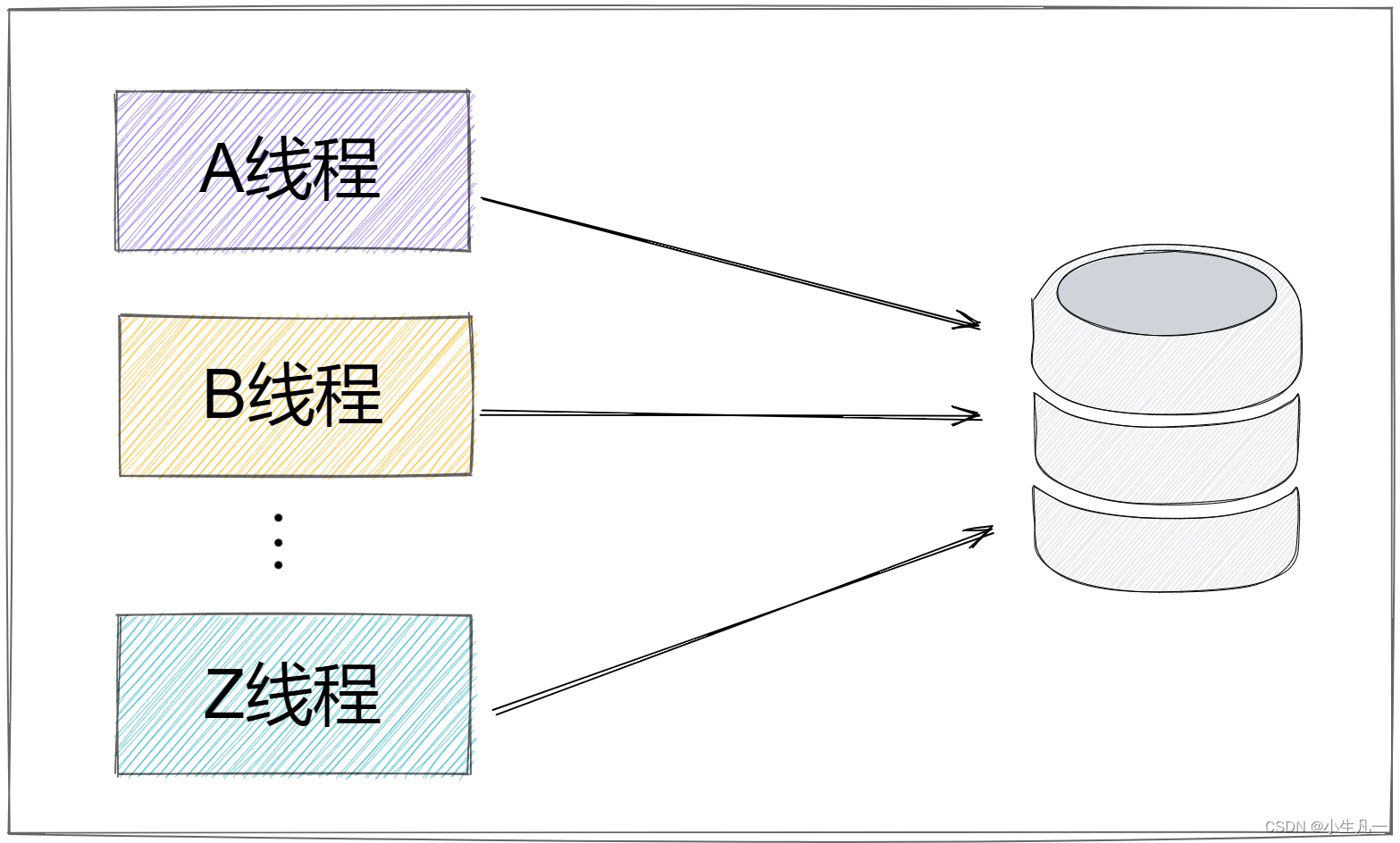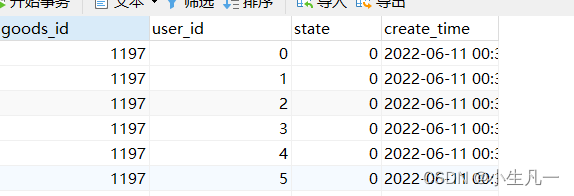【Go语言实战】 (13) 商品秒杀的本质以及Golang实现解决方案
写在前面
这是一篇关于Go语言实现商城秒杀的解决方案。
其实商城的秒杀就是高并发问题,那高并发下我们主要解决的就是数据竞争问题
源码:https://github.com/CocaineCong/Go-SecKill
当两个或多个协程同时访问同一个内存地址,并且至少有一个是在写时,就会发生数据竞争。比如A线程修改完之后,线程B读的是线程A之前的值(初始值),所以不知道A是否修改,所以会导致线程B也把自己修改的值放到这个内存地址中,就会导致本次修改无意义。

常用的方法就是加锁了,当这个进程已经执行了,就为该进程进行加锁,防止其他进程对这个数据进行修改,所以这个数据进行修改之后,再释放这个锁。
关于加锁,我们有两种锁机制,悲观锁和乐观锁。
- 悲观锁,就是什么时候都保持悲观状态,认为任何地点都会发生这种情况,所以都会加上一个锁,锁住这段逻辑代码。
- 乐观锁,就是什么时候都保持乐观状态,认为只有在修改的时候会发生问题,所以并不是一个真正意义上的锁,而是一个版本的管理,
保持一个数据的多版本,出现错误就进行回滚,类似MySQL的MVCC机制。
1. 场景说明
1.1 场景描述
本次秒杀商城,我们对数据库商品数量进行操作。
秒杀的商品

秒杀成功的名单

1.2 事务编写
初始化本次秒杀的商品
func InitializerSecKill(gid int) {
tx := model.DB.Begin() // 开启事务
err := model.DeleteByGoodsId(gid)
// 删除前一次秒杀的所有用户,既删除表 success_killed
if err != nil { // 发生错误的话就进行回滚
tx.Rollback()
}
err = model.UpdateCountByGoodsId(gid)
// 更新商品的信息表 promotion_sec_kill
if err != nil {
tx.Rollback()
}
tx.Commit()
}
- 1
- 2
- 3
- 4
- 5
- 6
- 7
- 8
- 9
- 10
- 11
- 12
- 13
- 14
开启50个线程并发进行秒杀
func WithoutLockSecKill(gid int) serializer.Response {
code := e.SUCCESS
seckillNum := 50
wg.Add(seckillNum)
InitializerSecKill(gid)
for i := 0; i < seckillNum; i++ {
userID := i
go func() {
err := WithoutLockSecKillGoods(gid, userID)
if err != nil {
fmt.Println("Error",err)
} else {
fmt.Printf("User: %d seckill successfully.\n", userID)
}
wg.Done()
}()
}
wg.Wait()
killedCount, err := GetKilledCount(gid)
if err != nil {
code = e.ERROR
logging.Error("Seckill System Error")
return serializer.Response{
Status: code,
Msg: e.GetMsg(code),
Error: err.Error(),
}
}
fmt.Println(killedCount)
logging.Infof("kill %v product", killedCount)
return serializer.Response{
Status: code,
Msg: e.GetMsg(code),
}
}
- 1
- 2
- 3
- 4
- 5
- 6
- 7
- 8
- 9
- 10
- 11
- 12
- 13
- 14
- 15
- 16
- 17
- 18
- 19
- 20
- 21
- 22
- 23
- 24
- 25
- 26
- 27
- 28
- 29
- 30
- 31
- 32
- 33
- 34
- 35
2. 单机模式
2.1 不加锁 出现超卖情况
api/v1/without-lock?gid=1197
func WithoutLockSecKillGoods(gid, userID int) error {
tx := model.DB.Begin()
// 检查库存
count, err := model.SelectCountByGoodsId(gid)
if err != nil {
return err
}
if count > 0 {
// 1. 扣库存
err = model.ReduceStockByGoodsId(gid, int(count-1))
if err != nil {
tx.Rollback()
return err
}
// 2. 创建订单
kill := model.SuccessKilled{
GoodsId: int64(gid),
UserId: int64(userID),
State: 0,
CreateTime: time.Now(),
}
err = model.CreateOrder(kill)
if err != nil {
tx.Rollback()
return err
}
}
tx.Commit()
return nil
}
- 1
- 2
- 3
- 4
- 5
- 6
- 7
- 8
- 9
- 10
- 11
- 12
- 13
- 14
- 15
- 16
- 17
- 18
- 19
- 20
- 21
- 22
- 23
- 24
- 25
- 26
- 27
- 28
- 29
- 30
2.2 加锁(sync包中的Mutex类型的互斥锁),没有问题
api/v1/with-lock?gid=1197
func WithLockSecKillGoods(gid,userID int) error {
lock.Lock()
err := WithoutLockSecKillGoods(gid, userID)
lock.Unlock()
return err
}
- 1
- 2
- 3
- 4
- 5
- 6
2.3 加锁(数据库悲观锁,读限定), 出现超卖
api/v1/with-pcc-read?gid=1197
func SelectCountByGoodsIdPcc(gid int) (int64, error) {
skGood:=PromotionSecKill{}
err := DB.Model(PromotionSecKill{}).Set("gorm:query_option", "FOR UPDATE").
Where("goods_id=?",gid).First(&skGood).Error
return skGood.PsCount, err
}
- 1
- 2
- 3
- 4
- 5
- 6
加入FOR UPDATE进行读锁。
2.4 加锁(数据库悲观锁,更新限定), 正常
api/v1/with-pcc-update?gid=1197
func ReduceByGoodsId(gid int) (int64, error) {
var count int64
sqlStr := `UPDATE promotion_sec_kill SET ps_count = ps_count-1 WHERE ps_count>0 AND goods_id = ?`
res := DB.Exec(sqlStr, gid)
if err := res.Error; err != nil {
return count, err
}
count = res.RowsAffected
return count, nil
}
- 1
- 2
- 3
- 4
- 5
- 6
- 7
- 8
- 9
- 10
ps_count>0 进行限定作用。
2.5 加锁(数据库乐观锁,正常)
api/v1/with-occ?gid=1197
func ReduceStockByOcc(gid int, num int, version int) (int64, error) {
var count int64
sqlStr := "UPDATE promotion_sec_kill SET ps_count = ps_count-?, version = version+1 " +
"WHERE version = ? AND goods_id = ?"
res := DB.Exec(sqlStr, num, version, gid)
if err := res.Error; err != nil {
return count, err
}
count = res.RowsAffected
return count, nil
}
- 1
- 2
- 3
- 4
- 5
- 6
- 7
- 8
- 9
- 10
- 11
使用version进行版本的控制,从而实现乐观锁。
2.6 使用 channel 限制,正常
api/v1/with-channel?gid=1197
func ChannelConsumer() {
for {
kill, ok := <-(*GetInstance())
if !ok {
continue
}
err := WithoutLockSecKillGoods(kill[0], kill[1])
if err != nil {
logging.Error("Error")
} else {
logging.Infof("User:%v SecKill Successfully", kill[1])
}
}
}
- 1
- 2
- 3
- 4
- 5
- 6
- 7
- 8
- 9
- 10
- 11
- 12
- 13
- 14
将每个商品id和用户id放入其中,然后可以把channel作为一把锁,起到了阻塞作用。
3. 分布式
3.1 环境搭建
- 搭建三主三从Cluster模式的Redis集群,配置Redisson
- 搭建ETCD集群
3.2 实现方法
3.2.1 基于Redisson的Redis分布式锁,正常
api/v2/with-redission?gid=1197
注意要用Redis Lock把整个事务提交都包住。这里仅仅使用了Redis分布式提供的锁功能,秒杀数据处理还是直接访问数据库来完成
func WithRedssionSecKillGoods(gid , userID int) error {
g := strconv.Itoa(gid)
uuid := getUuid(g)
lockSuccess, err := cache.RedisClient.SetNX(g, uuid, time.Second*3).Result()
if err != nil || !lockSuccess {
fmt.Println("get lock fail", err)
return errors.New("get lock fail")
} else {
fmt.Println("get lock success")
}
err = WithoutLockSecKillGoods(gid, userID)
if err != nil {
return err
}
value, _ := cache.RedisClient.Get(g).Result()
if value == uuid { //compare value,if equal then del
_, err := cache.RedisClient.Del(g).Result()
if err != nil {
fmt.Println("unlock fail")
return nil
} else {
fmt.Println("unlock success")
}
}
return nil
}
- 1
- 2
- 3
- 4
- 5
- 6
- 7
- 8
- 9
- 10
- 11
- 12
- 13
- 14
- 15
- 16
- 17
- 18
- 19
- 20
- 21
- 22
- 23
- 24
- 25
- 26
3.2.2 基于缓存的ETCD分布式锁,正常
api/v2/with-etcd?gid=1197
类似于之前使用BlockingQueue时编写了一个单例模式的工具类来全局使用的形式相同,注意这里也要用ETCD分布式锁把整个事务提交都包住。这里只用了ETCD的分布式锁功能,秒杀数据处理也是直接访问数据库来完成
func WithETCDSecKillGoods(gid, userID int) error {
var conf = clientv3.Config{
Endpoints: []string{"127.0.0.1:2379"},
DialTimeout: 5 * time.Second,
}
eMutex1 := &EtcdMutex{
Conf: conf,
Ttl: 10,
Key: "lock",
}
err := eMutex1.Lock()
if err != nil {
return err
}
err = WithoutLockSecKillGoods(gid, userID)
eMutex1.UnLock()
return err
}
- 1
- 2
- 3
- 4
- 5
- 6
- 7
- 8
- 9
- 10
- 11
- 12
- 13
- 14
- 15
- 16
- 17
- 18
3.2.3 Redis的List队列,正常
api/v2/with-redis-list?gid=1197
这里利用Redis分布式队列的方式是,在秒杀活动初始化阶段时有多少库存就在Redis的List中初始化多少个商品元素。
然后每有一个用户进行秒杀,就从List队列中取出一个商品元素分配给该用户。
同时将该用户信息存入到Redis的Set类型中,防止用户多次秒杀的情况。
在秒杀结束之后,在Redis中数据写入到数据库中进行保存。可参考下图:
func WithRedisListSecKillGoods(gid, userID int) error {
g := strconv.Itoa(gid)
u := strconv.Itoa(userID)
if cache.RedisClient.Get(u + g).Val() == "" { // 这用户没有秒杀过
cache.RedisClient.RPop(g)
cache.RedisClient.Set(u+g, g, 3*time.Minute)
cache.RedisClient.ZAdd(g, redis.Z{float64(time.Now().Unix()), userID})
} else { // 这用户已经有记录了
return errors.New("该用户已经抢过了")
}
return nil
}
- 1
- 2
- 3
- 4
- 5
- 6
- 7
- 8
- 9
- 10
- 11
- 12
3.2.4 Redis原子递减,正常
这里先将秒杀商品的库存数量,写入到redis中,利用redis的incr来实现原子递减。
假如有100件商品,这里相当于准备好了100个钥匙,有人没有抢到钥匙,就返回库存不够,有人抢到了钥匙,就进行下一步处理,先将秒杀订单的信息写入到redis中,等空闲下来后在写入到数据库中。这里其实与3.2.3差不多
其他
-
基于Redis的任务队列,订阅监听
(是将在前端进行秒杀的用户的信息传入到通道中,等待被消费。后端订阅监听这个通道,有秒杀用户信息传过来就进行消费处理,再将处理数据写入到数据库。) -
基于MQ消息队列的分布式锁
改进:
- 索引与SQL语句检查
- 尽可能利用缓存
- 利用MQ进行流量削峰
- Nginx负载均衡
- 读写分离与分表分库
- CDN内容分发网络
- 流量防刷和反爬虫
文章来源: blog.csdn.net,作者:小生凡一,版权归原作者所有,如需转载,请联系作者。
原文链接:blog.csdn.net/weixin_45304503/article/details/125237792
- 点赞
- 收藏
- 关注作者


评论(0)